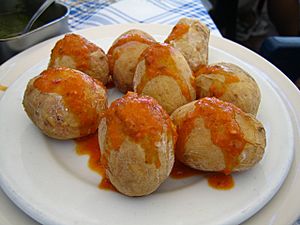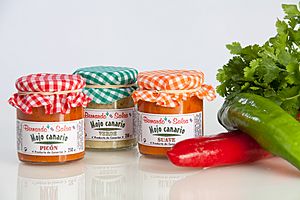Mojo (sauce) facts for kids
Mojo is a tasty sauce that comes from the Canary Islands. The word "mojo" comes from the Portuguese word molho, which means "sauce." There are many kinds of mojo, some are spicy and some are not.
Mojo is usually made with olive oil, local peppers, garlic, paprika, and spices like cumin or coriander. You might also find it with sour ingredients like vinegar, lemon, orange, or lime juice.
Contents
Mojo from the Canary Islands
Mojo first started in the Canary Islands. The two main types are red mojo (mojo rojo) and green mojo (mojo verde).
Types of Canarian Mojo
Green mojo is often made with green peppers. It's great with fish. There are also green mojos made with coriander (mojo de cilantro) or parsley (mojo de perejil). These green mojos have some water, so you need to keep them in the fridge. They should be eaten within two days.
Red mojo is made from small red peppers and paprika. People usually eat it with meat. Both red and green mojo can be used with papas arrugadas, which are special wrinkly potatoes. Mojo is also often served with fresh bread at the start of a meal.
How to Make Mojo
To make red mojo, the peppers are first dried. Dried peppers can be stored for a long time. Before making the sauce, the peppers are soaked in water. This helps them lose some of their spiciness. Then, most of the seeds and fibers are taken out. A few are left in to keep the mojo spicy.
For green mojo, the amount of garlic controls how spicy it is. You can also add ground coriander seeds to make it spicier.
Different Canarian Mojo Flavors
Families in the Canary Islands often have their own special mojo recipes. This means the taste, spiciness, and texture can be very different.
Some local mojos include:
- Mojo with cheese (mojo con queso): This is popular in La Palma and El Hierro.
- Almogrote: From La Gomera, this is a thick paste. You can spread it on bread.
- Almond mojo: This is perfect with roasted dishes.
- Saffron mojo: Made with Canarian saffron, it tastes great with fried cheese.
- Garlic mojo: This is a good topping for pizza.
- Herb mojo: Made from mixed spices, it's wonderful with salads.
Mojo Around the World
Similar sauces, also called mojo, are popular in other places. You can find them in Cuba and many islands in the Caribbean. This is because many people from the Canary Islands moved there long ago. These sauces have even influenced some barbecue sauces in the southern United States. The flavors can range from tomato or pepper to avocado.
Cuban Mojo
In Cuban cooking, mojo is a sauce made with garlic, olive oil or pork fat, and citrus juice. They traditionally use bitter orange juice. It's often used to flavor cassava (a root vegetable). It's also a popular marinade for roast pork. If it doesn't have oregano, it's called 'mojito'. This is used for dipping plantain chips and fried cassava.
Puerto Rican Mojo
In Puerto Rico, mojo is a herb sauce. It has finely chopped cilantro or parsley, salt, lots of crushed garlic, and olive oil. Sometimes, people add black pepper, butter, grated onion, vinegar, or other citrus fruits. It's often used to marinate roast chicken. It's also a dip for tostones (fried plantains) and fried cassava. Sometimes, it's mixed with mofongo (a dish made from mashed plantains).
Dominican Republic Wasakaka
In the Dominican Republic, a similar sauce is called wasakaka. It's used with roasted chicken and boiled cassava. Wasakaka is a mix of garlic, olive oil, and sour orange or lemon juice.
See also
 In Spanish: Mojo (salsa) para niños
In Spanish: Mojo (salsa) para niños



